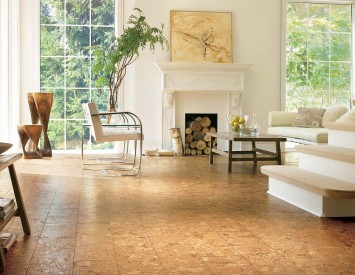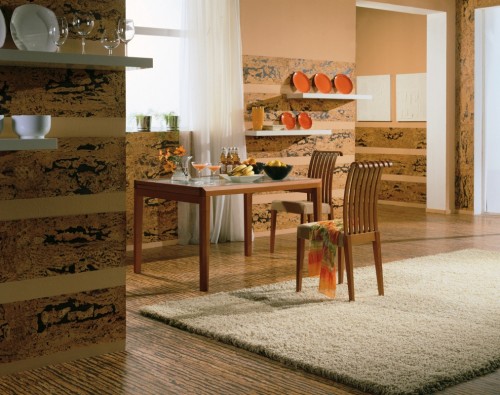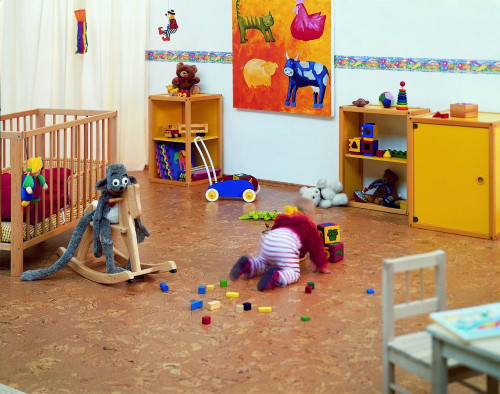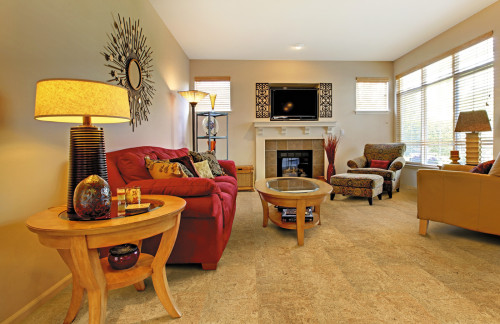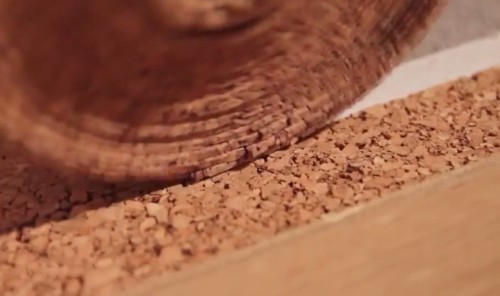The cork material is gradually becoming popular among the owners, and this is even despite the fact that there are even more practical solutions on the market. The thing is that cork coatings have many advantages that even parquet and laminate cannot boast.
Content
The good news also lies in the fact that on sale you can find a lot of different options for cork material that are ideal for specific conditions and scale. In modern conditions, it is advisable to use cork coatings. Moreover, this is not only about the floor options for the material. Now there are a lot of various coatings on sale. Some can be used as a wall finish, and some to cover the ceiling.
Of course, do not forget about the disadvantages of cork coatings. They really are of considerable importance, especially given the fact that floor coverings are constantly operated in the dwelling, so it is very important that they have excellent characteristics. We will dwell on the negative sides of the cork floors in this material.
We also consider the process of laying a cork floor, analyzing each stage of work in detail. Looking a little in advance, it should be noted that the cork floor is really a good option for a large private house and a small apartment in a multi -storey building.
The main features of cork material
Obviously, the cork floor is a completely natural product that has practically no analogues in the market. Of course, this is precisely the traffic jam and captivates consumers. It is also interesting that there are many options for these products on the market. Each owner has the opportunity to purchase the most practical option that will show itself on the best side in specific conditions.
Next, we consider the main varieties of cork flooring:
- Camping board. It must be borne in mind that this is the most expensive cork coating that can be found on the market. The material itself is large plates, the dimensions of which can reach six square meters. The thickness of the cork board is limited to 6 mm. Often this material is covered with wear -resistant varnish, since the cork board is very sensitive to a wide variety of influences.
- Cork laminate. This material is almost similar to the most ordinary laminate, but its characteristics are similar to the parameters of the cork board. Unfortunately, this flooring is rarely used.
- Pressed traffic jam. This is a kind of budget version of a cork stove. Despite this, the quality of the material is quite high, so the material does not have any special negative aspects. A pressed cork has a fine -grained texture that may not like many to many. It can also be noted the positive side, which concerns arbitrary dimensions of the material. Manufacturers do not limit themselves in this regard, so tiles from a pressed cork can be either miniature and giant.
- Cork panels MDF. This option of cork material has a low price. Externally, the material resembles a cork board, but most of all it has in common with a laminate. The material is based on MDF, after which there is a layer of cork crumb. This composition is completed by another layer, which consists of a thin cork veneer. The advantage of this coating is that for its arrangement it is not necessary to pay much attention to the quality of the underlying layer.
The main advantages and disadvantages of the cork floor
At the beginning of this material, we said that cork coatings have many advantages. Of course, they also have significant drawbacks, some of which can significantly affect the choice of consumers. Of course, there are much more positive aspects than negative sides, and it is worth remembering.
The advantages of the cork floor:
- Natural material. Many people are skeptical of modern materials that are produced on the basis of polymers and plastic. Obviously, in most cases, for humans, these building resources are not the best option, since they can have some disadvantages, primarily associated with the negative impact on human health. Sometimes this influence is almost insignificant, but in such situations, people are used to giving preference to natural products. Indeed, the traffic jam is environmentally harmful to human health. In this regard, this material is much more attractive than other flooring.
- Original coating. The bottom line is that the cork is quite elastic material. Accordingly, this is a great option for flooring in the children's room. This is a safer option than any other type of floor. Also, the coating of cork floors does not slip at all, unlike laminate and parquet. However, it must be remembered that on sale there are a wide variety of coatings that are suitable for a particular room. For example, we can talk about protective layers that protect the cork surface from the action of water or any other substances.
- Sound and thermal insulation. Natural material in its properties resembles mineral wool or foam. Indeed, the cork floor can be used as thermal insulation, and with the right approach, the material also isolates external noise. However, it is not necessary to overestimate the material in this regard, since the corpusive coating is still far from the properties of specialized products.
- Positive "perception" of the load. As we have already said, cork coatings are elastic, and that is why they perceive even very high loads well. Accordingly, if you place a heavy cabinet on the floor, the cork coating will pass a little. However, immediately after the cabinet is removed, the coating will return to the initial position. This is a great property that does not allow the material to be damaged even in the most severe conditions.
Disadvantages of cork coatings:
- High price. Those who wish to purchase a cork coating will have to pay a round amount. Of course, the whole point is that the material is natural, therefore, in such conditions, coating is always more appreciated. Of course, you can always purchase cheaper sex options that are also made on the basis of traffic jams, however, such solutions are deprived of the most important advantages of original cork coatings. Definitely, covering the floors in the whole house will be expensive, so it is sometimes advisable to limit yourself to one or a couple of rooms.
- Fragility. Despite the fact that cork material withstands serious loads, it is very easy to damage. It is just enough to stumble and hurt the surface. In this regard, cork coatings significantly lose to other decisions present in the market.
In addition, the cork has other negative aspects. For example, the material has a high sensitivity to temperature differences. Also, natural products absorb moisture too well.
If you analyze all of the above points, then cork floor can hardly be called durable. Just a year or two after the start of operation, it will be possible to notice significant problems on the coating, which cannot be restored. Accordingly, after some time you will have to replace the floor.
You also need to focus on the fact that cork coatings can only be used in separate rooms. It can be a nursery, a bedroom, a living room, as well as a study (hall). In some cases, you can use cork floors in other rooms, but only if the material has special protective coatings.
Cork coverage flooring
Necessary tools
In the process of laying cork coatings, you must have several tools:
- kiyanka;
- electrician;
- landing roller (if the floor needs to be planted on glue).
Also, in the process you will need skirting boards for the cork floor, as well as the species (since the cork coating cannot be laid in the doorways).
Preparatory work
Before starting laying a cork floor, you need to lead a number of responsible preparatory measures.
First of all, we are talking about leveling the concrete floor. Often, a concrete screed is created for this, but the problem is that the concrete surface has a slight roughness, which, in turn, creates serious problems for the cork layer.
In such cases, it is advisable to use a liquid leveling.
In addition, you can lay a cork floor over linoleum or laminate. In this case, it is also important to be sure that the base has an even surface.
Laying a cork floor based on glue
You need to know that the quality of the adhesive cork floor directly depends on the quality of the glue. Unfortunately, there are a lot of poor -quality products on sale, so it is very easy to encounter problems. It is best to use non -toxic glue, which dries for 10 minutes. The best information related to the choice of glue is best to clarify the coating manufacturer, since it is very easy to make a mistake in choosing a product. However, it is worth mentioning that often PVA glue is not used in this process, since it has a water base.
- The laying of the cork coating begins with the center of the room. The process itself occurs in a spiral. At the very beginning, the glue is applied to the base. In this case, you need to ensure that the glue layer is the same.
- Each part of the coating should be rolled with a roller that we talked about earlier. You should not press too much, but you need to be sure that the cork coating is securely located on the surface.
- Using the most ordinary building level, you need to check the horizontal surface. Moreover, this procedure is carried out after laying almost every unit of material.
- In the event that the material begins to “lift up” a little, it is necessary to arm yourself with a rubber hammer and return the cork to its original position.
- In the process, situations will definitely take place in which glue will go out (between the gaps). In such a situation, you need to immediately remove excess glue using a rag (it is advisable to moisten it with a solvent).
- Along the perimeter of the room, it is necessary to leave a small interval that will serve as a plinth space.
Creating a floating floor
If it comes to creating a floating floor, then it can consist of whole pieces of veneer, or a cork laminate. It should be noted that the first option is quite complicated, so we will consider in detail the process of creating a floating floor based on a cork laminate.
- At the very beginning, measurements of the room occur. It must be borne in mind that the material is quite expensive, so it is better to purchase an exclusively necessary amount of material. If there is a need, it will be possible to buy a laminate later. Immediately after the purchase, the material cannot be used. It is necessary to withstand the cork product indoors during the day (this is a kind of acclimatization process).
- The base surface is covered with a film (overlap). It will also be required to ensure the walls. After the repair, it will be possible to cut off the excess part of the material. In places where joints are created, tape can be used.
- Now you need to take care of the dimensions of the laminate. The thing is that in the process a situation will definitely occur in which the sizes of the planks will not coincide with the dimensions of the room. In this case, you need to cut the material, but only from the crest. In no case should you cut the laminate from the side of the groove.
- The laying of the material comes from the far corner. The comb of the next unit of the material is placed in the groove of the previous plank. You also need to do everything so that there are small indexes around the wall (up to 30 mm).
- At this stage, the excess part of the film layer is cut off with a construction knife.
- With the help of mounting glue along the perimeter of the room, the skirting board is attached (preferably cork). The skirting board itself should hang over the surface a couple of millimeters.
- After the work carried out, the floor can be immediately operated.
